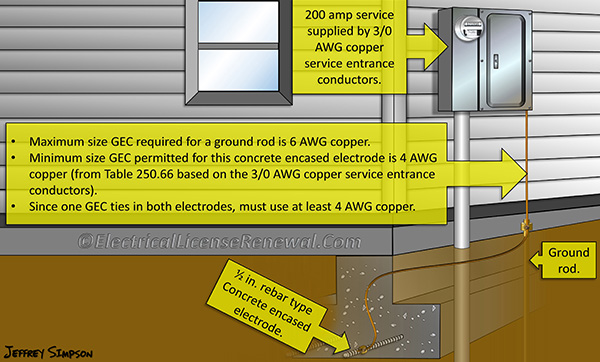250.66 Size of Alternating-Current Grounding Electrode Conductor.

Code Change Summary: A revision was made to clarify the proper way to size certain grounding electrode conductors (GEC’s).
The previous code language seemed to be pretty clear before but for some reason, many people were still confused by the wording.
A grounding electrode conductor (GEC) from an electrical service to a ground rod, pipe or plate type electrode is never required to be larger than 6 AWG copper or 4 AWG aluminum unless the GEC continues on from the rod, pipe or plate to connect another electrode that may require a larger GEC such as a concrete encased electrode, building steel or metal underground water pipe that qualifies as a grounding electrode.
The minimum size GEC permitted to connect a concrete encased electrode is 4 AWG copper. Building steel and metal underground water piping that qualifies as a grounding electrode may require a larger GEC since the GEC to these electrodes is sized based on the size of the service entrance conductors and Table 250.66. It would not be code compliant to run a 6 AWG copper GEC from the service to a ground rod, and then run a GEC bond jumper from the rod to another grounding electrode that required a larger GEC such as a concrete encased electrode.
Consider a ground rod for example; If the GEC starts at the service and goes to a ground rod or group of ground rods and stops there, the GEC is never required to be larger than 6 AWG copper or 4 AWG aluminum. If the GEC continues from the rod to another electrode of a different type that requires a larger GEC, then the GEC from the service to the first rod will be under sized for the furthest grounding electrode.
The above principle was an example of the code change to 250.66(A). The same change occurred in 250.66(B & C) which applies to concrete encased electrodes and ground rings.
Below is a preview of Article 250. See the actual NEC® text at NFPA.ORG for the complete code section. Once there, click on their link to free access to the 2017 NEC® edition of NFPA 70.
2014 Code Language:
250.66(A) Connections to a Rod, Pipe, or Plate Electrode(s). Where the grounding electrode conductor is connected to a single or multiple rod, pipe, or plate electrode(s), or any combination thereof, as permitted in 250.52(A)(5) or (A)(7), that portion of the conductor that is the sole connection to the grounding electrode(s) shall not be required to be larger than 6 AWG copper wire or 4 AWG aluminum wire.
2017 Code Language:
250.66(A) Connections to a Rod, Pipe, or Plate Electrode(s). If the grounding electrode conductor or bonding jumper connected to a single or multiple rod, pipe, or plate electrode(s), or any combination thereof, as described in 250.52(A)(5) or (A)(7), does not extend on to other types of electrodes that require a larger size conductor, the grounding electrode conductor shall not be required to be larger than 6 AWG copper wire or 4 AWG aluminum wire.